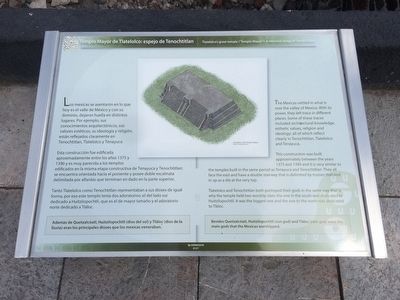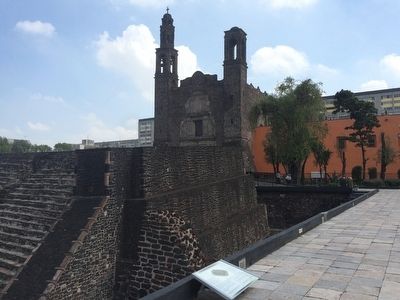Colonia Tlatelolco in Ciudad de México, Mexico — The Valley of Mexico (The Central Highlands)
Tlatelolco’s great temple (“Templo Mayor”): A mirrored image of Tenochtitlan
Templo Mayor de Tlatelolco: espejo de Tenochtitlan
Inscription.
Los mexicas se asentaron en lo que hoy es el valle de México y con su dominio, dejaron huella en distintos lugares. Por ejemplo, sus conocimientos arquitectónicos, sus valores estéticos, su ideología y religión, están reflejados claramente en Tenochtitlan, Tlatelolco y Tenayuca.
Esta construcción fue edificada aproximadamente entre los años 1375 y 1390 y es muy parecida a los templos edificados en la misma etapa constructiva de Tenayuca y Tenochtitlan: se encuentra orientada hacia el poniente y posee doble escalinata delimitada por alfardas que terminan en dado en la parte superior.
Tanto Tlatelolco como Tenochtitlan representaban a sus dioses de igual forma, por eso este templo tenía dos adoratorios: el del lado sur dedicado a Huitzilopochtli, que es el de mayor tamaño y el adoratorio norte dedicado a Tláloc.
Además de Quetzalcóatl, Huitzilopochtli (dios del sol) y Tláloc (dios de la lluvia) eran los principales dioses que los mexicas veneraban.
Pie de dibujo:
Isométrico del Templo Mayor
Dibujo: Fernando Botas Vera
The Mexicas settled in what is now the valley of Mexico. With its power, they left trace in different places. Some of these traces included architectural knowledge, esthetic values, religion and ideology; all of which reflect clearly in Tenochtitlan, Tlatelolco and Tenayuca.
This construction was built approximately between the years 1375 and 1390 and it is very similar to the temples built in the same period as Tenayuca and Tenochtitlan. They all face the east and have a double stairway that is delimited by trusses that end in up as a die at the very top.
Tlatelolco and Tenochtitlan both portrayed their gods in the same way that is why the temple held two worship sites: the one in the south was dedicated to Huitzilopochtli. It was the biggest one and the one to the norther was dedicated to Tláloc.
Besides Quetzalcóatl, Huitzilopochtli (sun god) and Tláloc (rain god) were the main gods that the Mexicas worshipped.
English translation of caption:
Isometric diagram of the Templo Mayor
Drawing: Fernando Botas Vera
Topics. This historical marker is listed in these topic lists: Anthropology & Archaeology • Man-Made Features. A significant historical year for this entry is 1375.
Location. 19° 27.058′ N, 99° 8.25′ W. Marker is in Ciudad de México. It is in Colonia Tlatelolco. The marker is at the Tlatelolco Archeological Site on Eje Central
near the intersection with Avenida Ricardo Flores Magón. Touch for map. Marker is in this post office area: Ciudad de México 06900, Mexico. Touch for directions.
Other nearby markers. At least 8 other markers are within walking distance of this marker. The Calendar Temple (a few steps from this marker); Full color Tlatelolco: The temple of the paintings (within shouting distance of this marker); The Palace (within shouting distance of this marker); Stage 1 of the Templo Mayor de Mexico Tlatelolco (within shouting distance of this marker); Tzompantli altar (“flag of heads”) of the south. (within shouting distance of this marker); The Tlatelolco Lovers (within shouting distance of this marker); Coyolxauhqui: The dismembered goddess (within shouting distance of this marker); Superimposed altars (within shouting distance of this marker). Touch for a list and map of all markers in Ciudad de México.
Credits. This page was last revised on April 17, 2020. It was originally submitted on January 4, 2016, by J. Makali Bruton of Accra, Ghana. This page has been viewed 634 times since then and 7 times this year. Photos: 1, 2. submitted on January 4, 2016, by J. Makali Bruton of Accra, Ghana.

